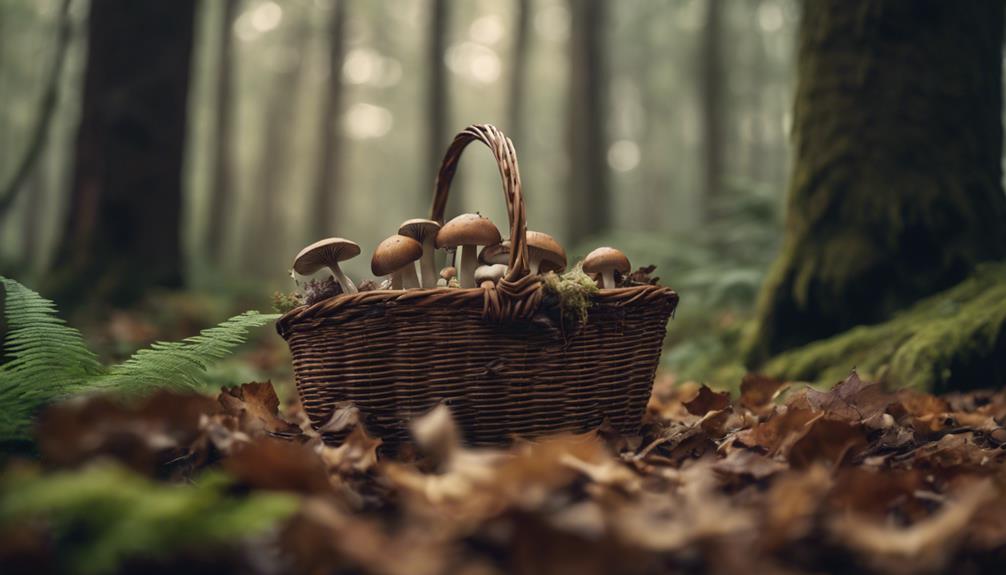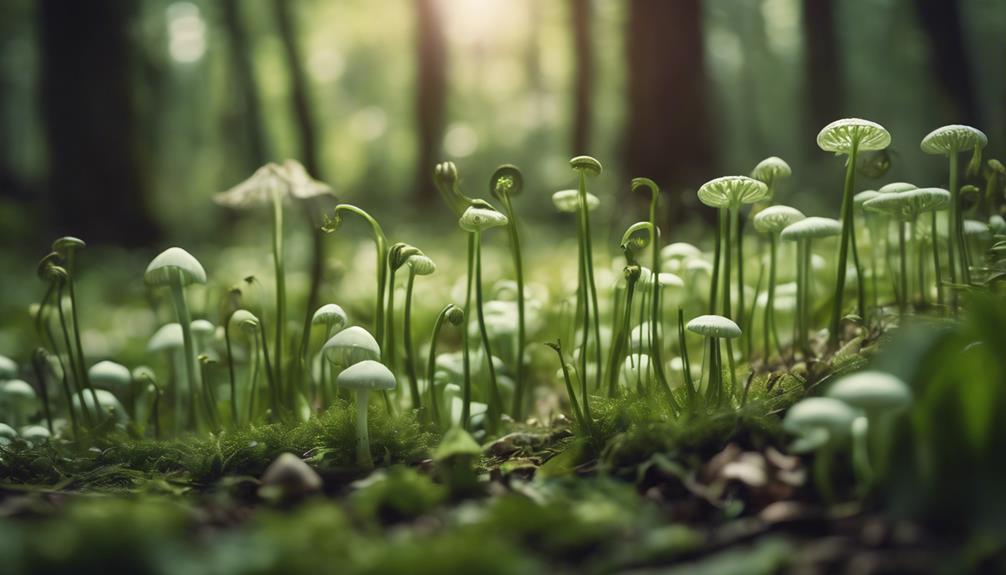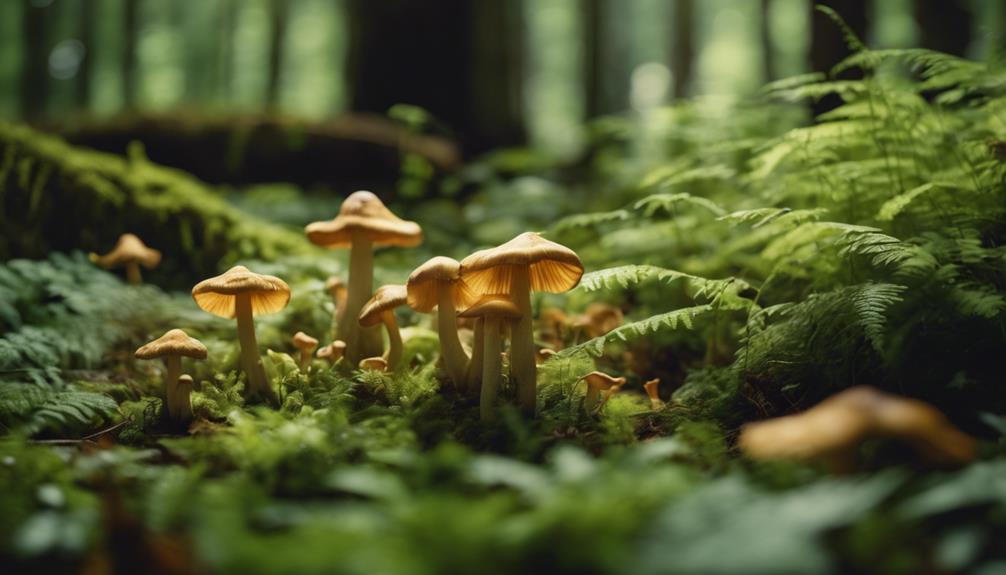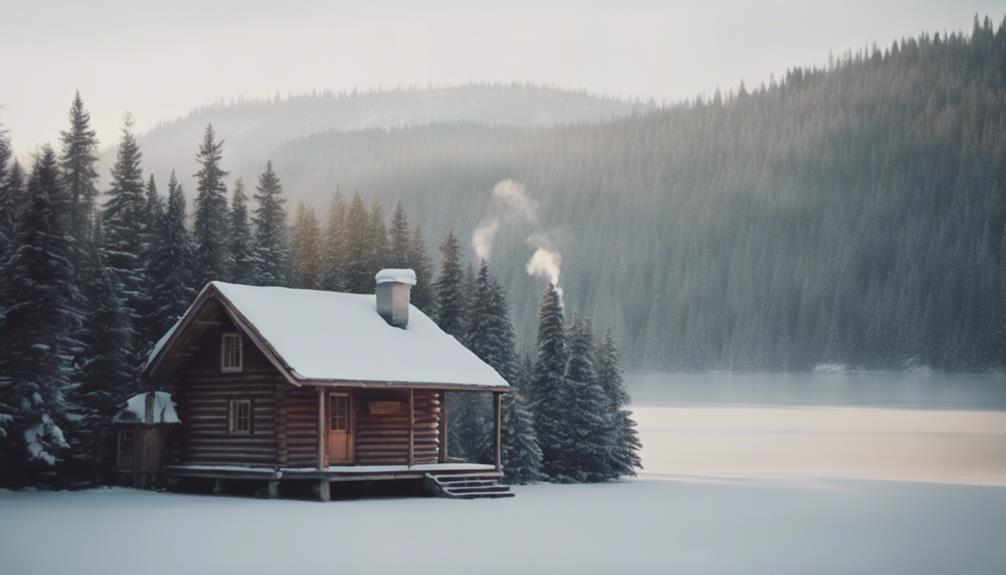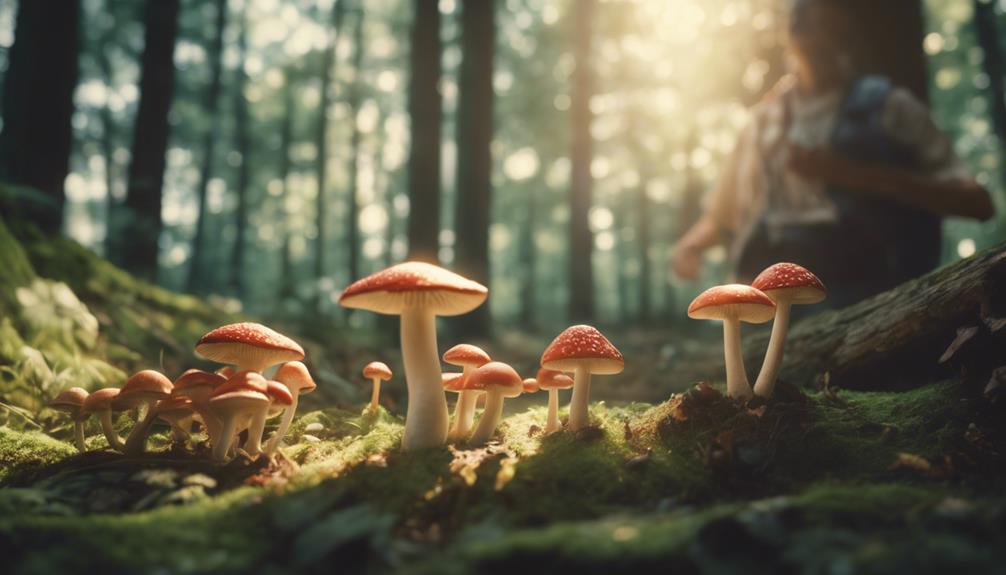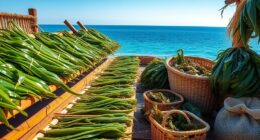You can forage for mushrooms in the UK, but it's vital to understand the complex web of laws, regulations, and best practices involved to guarantee a safe and sustainable experience. You're allowed to forage on public land for personal use, but you'll need permission from landowners for private property foraging. Be aware of protected species, and prioritize safety by accurately identifying edible species and avoiding toxic lookalikes. Respect the environment, practice sustainable foraging, and follow guidelines to minimize your impact. By doing so, you'll not only enjoy your foraging experience but also contribute to preserving the UK's biodiversity for future generations. Now, take the next step to uncover the intricacies of mushroom foraging in the UK.
Key Takeaways
- In the UK, foraging for mushrooms is allowed on public land for personal use, but permission is needed for private property.
- It's essential to accurately identify edible species to avoid toxic lookalikes, and consult reliable resources for proper identification.
- Commercial foraging may require licenses or permits, and laws can differ between Scotland and England.
- Ethical foraging practices, such as respecting private property and preserving biodiversity, are crucial for the ecosystem's balance.
- Developing mushroom identification skills through workshops, field guides, and online resources is vital for safe and responsible foraging.
Understanding Mushroom Foraging Laws
Before you head out to forage for mushrooms in the UK, it's vital to understand the laws that govern this activity to avoid legal trouble and promote sustainable foraging practices.
Foraging on public land is generally allowed for personal use, but you'll need permission from landowners if you want to forage on private property. Be aware that picking rare or protected mushroom species is illegal under UK law, so make sure you know what you're collecting.
Commercial foraging activities, such as selling mushrooms, may require licenses or permits to operate legally. It's also important to note that laws regarding mushroom foraging can differ between Scotland and England, so it's necessary to familiarize yourself with local regulations.
Remember to respect protected areas and follow regulations to forage responsibly in the UK. By understanding these legal aspects of foraging, you can enjoy this activity while minimizing your impact on the environment and avoiding legal issues.
Identifying Edible Mushroom Species

To identify edible mushroom species, you'll need to study specific characteristics like cap shape, gills, stem, and spore print color to distinguish them from their toxic lookalikes. When foraging for wild mushrooms in the UK, it's important to focus on key features that set edible species apart from their poisonous counterparts.
Here are three essential factors to keep in mind when identifying edible mushrooms:
- Unique Characteristics: Look for distinct features like a pleasant aroma, firm texture, and absence of a ring on the stem.
- Habitat Preferences: Understand the typical environments where edible mushrooms thrive, such as fields, forests, or woodlands.
- Bruising Reactions: Observe how the mushroom reacts to being cut or bruised, as some species will change color or exhibit other distinct reactions.
Safe Foraging Practices and Precautions

As you venture into the world of mushroom foraging, it's essential you prioritize safety above all else.
You'll need to accurately identify edible species and avoid their deadly lookalikes, which can be a matter of life and death.
Identify Edible Species
When venturing into the wild to forage for mushrooms, you'll want to develop a keen eye for identifying edible species to guarantee a safe and rewarding experience. Edible species like parasol mushrooms, field mushrooms, and horse mushrooms can be a delight to forage, but it's important to identify them accurately. However, not all mushrooms are safe to consume, as many toxic varieties resemble their edible counterparts. It’s crucial to consult a reliable field guide or expert while foraging to avoid any dangerous mistakes. Similarly, if you plan to forage for chestnuts safely, be sure to recognize the difference between edible chestnuts and toxic horse chestnuts to prevent any unintended harm.
To make sure you're picking the right mushrooms, follow these essential steps:
- Study distinctive characteristics: Familiarize yourself with the cap shape, gills, stem, and spore color of edible mushrooms to accurately identify them.
- Consult reliable resources: Use trusted field guides, online resources, and expert advice to verify proper identification before consuming any wild mushrooms.
- Prioritize safety: Avoid picking mushrooms with toxic lookalikes, such as deadly Amanita species, and put safety first by consulting experienced foragers.
Avoid Deadly Lookalikes
Your safety in the wild depends on your ability to distinguish edible mushrooms from their deadly lookalikes. When foraging for mushrooms in the UK, it's essential to be aware of the potential risks associated with misidentification. Certain toxic fungi, like the deadly Amanita species, have lookalikes that can be dangerously mistaken for edible mushrooms.
| Edible Mushroom | Deadly Lookalike |
|---|---|
| Chanterelle | Jack O'Lantern Mushroom |
| Oyster Mushroom | Poisonous Lookalike (e.g., Hemlock) |
| Morel Mushroom | False Morel (Gyromitra esculenta) |
| Honey Mushroom | Poisonous Lookalike (e.g., Deadly Webcap) |
To safeguard your foraging experience, always follow the principle of 'If in doubt, leave it out' when unsure about plant or mushroom edibility. Never consume unknown plants or mushrooms, as accidental poisoning from deadly lookalikes can be fatal. By exercising caution and accurately identifying edible mushrooms, you can enjoy a safe and rewarding foraging experience in the UK.
Essential Mushroom Foraging Etiquette

Before you head out to forage for mushrooms, make sure you understand and respect the essential etiquette guidelines that come with this hobby. As a responsible forager, it's important to be mindful of the environment, property rights, and the impact of your actions on the ecosystem.
Here are three essential etiquette guidelines to keep in mind:
- Respect private property: Always ask for permission before foraging on private land to avoid trespassing and make sure you're not disturbing the landowner's wishes.
- Preserve biodiversity: Be mindful of protected or rare mushroom species and avoid picking them to maintain the delicate balance of the ecosystem.
- Practice sustainable foraging: Only take what you need, and leave the environment undisturbed to secure the sustainability of the ecosystem for future generations.
Learning Mushroom Identification Skills

Developing a keen eye for detail is crucial to accurately identify the fascinating array of mushroom species found in the UK.
When it comes to learning mushroom identification skills, focusing on distinctive characteristics like cap shape, gills, spore print color, and stem features is vital.
Joining foraging workshops or courses can provide hands-on practice with experienced foragers, helping you develop your skills.
Utilize reliable field guides and resources specific to UK mushroom varieties to enhance your learning. Start by focusing on common edible species, like chanterelles or oyster mushrooms, to build a strong foundation in mushroom identification.
Remember, safety should always be your top priority, so prioritize cross-referencing multiple sources before consuming any wild mushrooms.
Common Mistakes to Avoid Foraging

As you venture out to forage for mushrooms, being mindful of common mistakes that can have serious consequences is crucial.
You'll want to avoid misidentifying mushrooms that resemble edible species but are actually poisonous, as well as incorrectly identifying rare or endangered species.
Incorrect Identification
When foraging for mushrooms, incorrect identification can be a matter of life and death, and recognizing the common mistakes that can lead to poisoning or severe illness is important. As you venture into the world of wild food, being mindful of the pitfalls that can lead to misidentification is necessary.
Here are some common mistakes to avoid:
- Relying on a single source: Don't trust a single field guide or online resource. Cross-reference multiple sources to confirm accuracy.
- Lack of knowledge: Don't assume you can identify a mushroom based on a single characteristic. Take the time to learn about the unique features of each species.
- Ignoring expert advice: Consult with experienced foragers, mycologists, or experts in the field to get a second opinion.
Poisonous Lookalikes
To avoid the risks of misidentification, it's essential to familiarize yourself with the poisonous lookalikes that can masquerade as edible mushrooms, and know how to distinguish them from their harmless counterparts.
You don't want to mistake a deadly webcap or fool's webcap for a harmless field mushroom. The consequences can be severe.
Similarly, the yellow stainer, a poisonous lookalike, can cause severe illness if consumed.
Another dangerous mushroom to avoid is the false morel, which resembles the true morel.
Proper identification and knowledge of distinguishing features are vital to avoid picking poisonous mushroom lookalikes. Don't rely on appearance alone; take the time to examine the mushroom's shape, size, color, and habitat.
Be cautious and do your research to avoid common mistakes. Remember, it's always better to err on the side of caution when foraging for mushrooms in the UK.
Sustainable Foraging for the Future

By adopting sustainable foraging practices, you'll play an essential role in preserving the UK's rich biodiversity for generations to come. As a responsible forager, you can make a positive impact on the environment by ensuring the long-term health of ecosystems. This involves respecting seasonal availability, limiting harvest quantities, and leaving no trace in natural areas.
To get started with sustainable foraging, follow these guidelines:
- Respect seasonal availability: Only harvest species that are in season to avoid depleting populations.
- Limit harvest quantities: Take only what you need, and avoid over-harvesting to preserve the ecosystem's balance.
- Leave no trace: Minimize your impact on the environment by not littering, disturbing habitats, or damaging vegetation.
Respecting the Environment and Wildlife

Respecting the environment and wildlife is vital as you venture out to forage for mushrooms in the UK, ensuring your actions don't harm the very ecosystems that sustain these valuable resources. As you forage, remember to leave no trace, preserving the natural balance and avoiding damage to vegetation or disturbance to wildlife habitats.
It's essential to be mindful of rare or protected mushroom species, avoiding their collection to safeguard biodiversity. Foraging legal guidelines emphasize the importance of responsible practices, ensuring that your actions promote sustainability and harmony with the natural environment.
This means being aware of your surroundings, avoiding sensitive habitats, and not damaging vegetation or disturbing wildlife. By adopting these ethical guidelines, you can contribute to a more sustainable foraging culture, preserving the beauty and richness of the UK's natural environment for future generations.
Further Learning and Community Resources

As you refine your foraging skills, you'll want to explore additional resources to deepen your knowledge and connect with like-minded enthusiasts.
To further your learning, consider the following:
- Recommended reading: Explore books on plant and mushroom identification to deepen your knowledge of edible wild species.
- Online communities: Join Facebook groups dedicated to foraging, where you can connect with others, ask questions, and share your experiences.
- Podcasts and tutorials: Tune in to podcasts discussing the therapeutic benefits of nature immersion and foraging on mental health, and explore online tutorials for hands-on learning.
Frequently Asked Questions
Can You Forage for Mushrooms in the Uk?
You can forage for mushrooms in the UK on public land for personal use, but you'll need permission on private land and must avoid protected areas and rare species, ensuring a safe and legal experience.
Can I Eat Mushrooms From My Garden Uk?
"Your garden is a treasure trove, but beware, for hidden among the blooms, deadly doppelgangers lurk. Before savoring a wild mushroom, you must identify it with certainty, or risk a toxic tale."
Where Is Forage Legal in Uk?
You can forage legally in most UK public areas, like forests and parks, but you'll need permission for private land, and some areas, like Scotland, have specific rules, so research local laws before you head out.
Are Mushrooms Safe to Eat in the Uk?
You're venturing into the wild mushroom world, where uncertainty lurks like a hidden trapdoor. Are mushrooms safe to eat in the UK? Not all, you'll find some edible, some poisonous, and some inedible varieties, so exercise extreme caution and expert guidance before taking a bite.
Conclusion
As you begin your mushroom foraging journey, remember that practice makes perfect, and patience is key.
Don't be discouraged by initial setbacks – 'when the student is ready, the teacher will appear.'
By following the guidelines outlined in this guide, you'll be well on your way to becoming a skilled mushroom forager.
Stay curious, keep learning, and always prioritize safety and sustainability.
Happy foraging!

